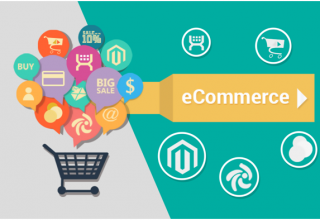Are you ready to transform your existing brick-and-mortar store into an online shopping experience? Sure, opening your local store must’ve felt great at first! As a sensible next step, you must expand your customer base and think globally by selling online.
The statistics of early 2019 reveal the share of online sales in the US was higher than general merchandise sales for the first time ever. After all, the internet is the biggest marketplace in the world, bringing customers from all over the world to one platform. No wonder online sales are becoming more popular with each passing year!
Whether big or small, any business can jump to an e-commerce model. The transition starts with pre-launch preparations:
Business Strategy: Steps of Pre-launch Preparation:
Establish who your main customers are –
Before building your virtual storefront, you need to determine who your primary customers are and how they will find your online presence. Your captive brick-and-mortar customer base is a great starting point.
Select a suitable domain name –
The domain name should be catchy, SEO-friendly, and in line with your target audience. Another option is to stick with your existing brand name, especially if it’s already catchy, SEO-friendly, and available. If it’s not, and your brand depends on organic traffic, then new branding through an SEO-friendly domain should be considered.
Streamline product lines and price points for the initial launch period –
With a broader audience in the pipeline, you will need to perfect your production scheduling to avoid any delays that will affect delivery waiting times, especially when shipping internationally. This is a sure-shot way to appeal to the widest possible audience from the very start. It’s also recommended that you analyze how your competitors are pricing similar products. Total prices should be evaluated (cost plus shipping and taxes), so as to ensure you’re pricing fairly and competitively. Try to use a flat shipping rate and special offers for regular buyers.
Write brief to the point page titles, product descriptions, and meta descriptions –
You can’t afford to waste time doing this part later; its best to do the groundwork now so that you can launch your virtual marketplace ASAP.
Take photographs of your inventory –
Basic tips for this include: take high-quality original photos; use a white background; don’t go for stock photos from the web (these are not SEO friendly); run the pictures through a reliable photo editing software like Photoshop.
Choose the best payment methods:
Always choose the easiest payment methods and those that accommodate the widest audience. ‘Apple Pay’ and ‘Google Pay’ are examples of easy and popular methods. ‘Square Pos’ allows you to accept both Apple and Google Pay, as well as most major credit and debit cards, and connects your online and brick-and-mortar metrics on a single dashboard.
Devise a clear-cut shipping and refund policy –
Such policies, when in place, help build a relationship of trust between the business and its customers. The return process should be made easy for buyers, by offering a reasonable timeframe for returns. Customer loyalty and higher conversion rates are directly impacted by the friendliness and transparency of such policies.
“Content is King.”
Organic SEO content will attract visitors to your website. In the early stages, when you’re going live with your virtual store, at least you should have come up with content, engaged with your customers on social media, and written SEO-driven product descriptions. The aesthetics of your website can be taken care of later, foremost importance should be given to the SEO friendliness of the content.
Optimization and Marketing
With a solid business strategy and the above groundwork in place, once your website is up and running, it’s time to focus on the aesthetics and the constant process of building great SEO content. This process of jacking up the aesthetics and building upon content is called Optimization of your online store.
After developing a sound business strategy followed by converting leads through optimization, you need to have a good marketing plan to get your e-commerce business off the ground.
Let’s take a look at the aspects of optimization and marketing crucial for taking your business online:
Optimization:
- Work on the design of your website and the Mobile platform. Making your website look beautiful is wise, but what you really need to focus on is mobile commerce. Mobile commerce made up nearly 60% of digital sales in 2017. Google prioritizes sites that are optimized for mobile devices. Also, we can’t stress enough on the convenience, shopping experience, and great customer service policies, being crucial aspects of overall website design. Finally, while the homepage is important, you need to spend more time on designing the product pages (product descriptions) than the homepage.
- Continue writing SEO content. As mentioned earlier, developing SEO-driven content isn’t something you do once-off, it’s an ongoing process. Always having fresh new content, benefits the reader in multiple ways.
Marketing:
- If you have a small business, it’s recommended that you do your own digital marketing rather than outsourcing it. This gives you a better understanding of your customers’ needs and expectations through social media interactions.
- You can improve your websites overall performance by using Google Search Console (GSC). GSC allows you to compare a list of keywords on your site with a list of keywords users commonly search for. It also lets you see just how many impressions your keywords are getting. Once you get a better idea of the types of keywords and phrases your customers are searching for, you can then incorporate this information into your titles, product descriptions, meta descriptions, and image tags for an added SEO boost.
- Implement an outbound marketing strategy. This helps in brand awareness and engagement with loyal and prospective customers. This could be through: rewarding your customers for referrals they provide; rewarding your customers for sharing your products with their friends on social media; enrolling customers on loyalty, VIP, and referral programs; emailing discount coupons to abandoned check out carts.
- Implementing customer surveys to gather feedback and devise a detailed FAQ section on your website; google analytics to pinpoint any drop-off points, and optimizing your website for speed, are other techniques that will increase conversion rates.
Conclusion
It shouldn’t surprise you if your online sales lag in the first few months to a year after going live. It’s a well-accepted fact that following the initial launch of their e-commerce site, many businesses report their brick-and-mortar stores to benefit from a huge boost in sales. This happens because customers browse products online, and follow it up with purchases at the physical stores.
It takes courage and hard work to take your business online. Once, you do take the leap forward, the opportunities for revenue growth are promising and seemingly limitless.













